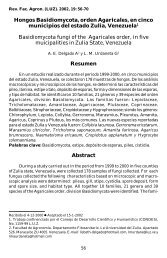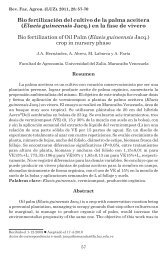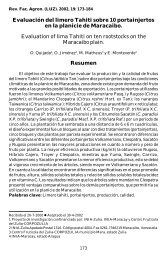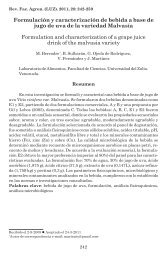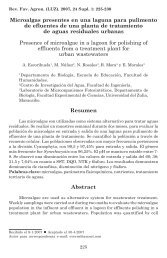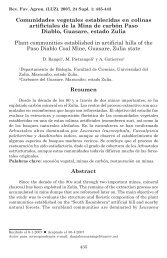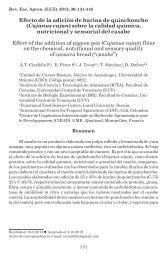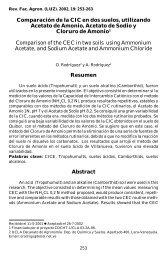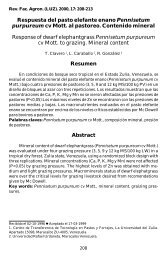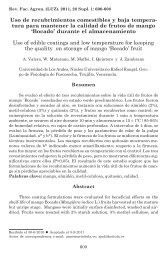Las industrias procesadoras de plátano (Musa AAB) en el Sur del ...
Las industrias procesadoras de plátano (Musa AAB) en el Sur del ...
Las industrias procesadoras de plátano (Musa AAB) en el Sur del ...
You also want an ePaper? Increase the reach of your titles
YUMPU automatically turns print PDFs into web optimized ePapers that Google loves.
Rev. Fac. Agron. (LUZ). 2010, 27: 144-161<br />
<strong>Las</strong> <strong>industrias</strong> <strong>procesadoras</strong> <strong>de</strong> plátano (<strong>Musa</strong> <strong>AAB</strong>)<br />
<strong>en</strong> <strong>el</strong> <strong>Sur</strong> <strong>de</strong>l Lago <strong>de</strong> Maracaibo, la región<br />
c<strong>en</strong>tral y capital <strong>de</strong> V<strong>en</strong>ezu<strong>el</strong>a<br />
Plantain (<strong>Musa</strong> <strong>AAB</strong>) processors industries in the south<br />
of Maracaibo Lake, C<strong>en</strong>tral and Capital<br />
regions of V<strong>en</strong>ezu<strong>el</strong>a<br />
E. Rebolledo, J. Salazar y M. Rebolledo<br />
Instituto <strong>de</strong> Economía y Ci<strong>en</strong>cias Sociales, Facultad <strong>de</strong> Agronomía,<br />
Universidad C<strong>en</strong>tral <strong>de</strong> V<strong>en</strong>ezu<strong>el</strong>a, Maracay, Edo.Aragua, V<strong>en</strong>ezu<strong>el</strong>a.<br />
Apto. Postal: 4579.<br />
Resum<strong>en</strong><br />
Se realizó un estudio para conocer <strong>el</strong> uso actual y pot<strong>en</strong>cial <strong>de</strong>l plátano <strong>en</strong><br />
siete <strong>industrias</strong> (2 gran<strong>de</strong>s y 5 medianas), ubicadas <strong>en</strong> la región C<strong>en</strong>tral (Aragua,<br />
Carabobo y Coje<strong>de</strong>s), la región Capital (Distrito Capital, Miranda, Vargas) y <strong>el</strong><br />
<strong>Sur</strong> <strong>de</strong>l Lago <strong>de</strong> Maracaibo. Se diseño un cuestionario para conocer la diversidad<br />
<strong>de</strong> productos, <strong>el</strong> orig<strong>en</strong> <strong>de</strong> la materia prima y la inclinación <strong>de</strong> las empresas a<br />
<strong>de</strong>sarrollar nuevos productos. <strong>Las</strong> empresas estudiadas <strong>el</strong>aboran dos productos a<br />
base <strong>de</strong> plátano: hoju<strong>el</strong>as fritas y tostones o patacones precong<strong>el</strong>ados. <strong>Las</strong> hoju<strong>el</strong>as<br />
<strong>de</strong> plátano frito ti<strong>en</strong><strong>en</strong> cuatro pres<strong>en</strong>taciones (con ajo, naturales, picante y<br />
maduro), empacados <strong>en</strong> bolsas plásticas <strong>de</strong> tres tamaños difer<strong>en</strong>tes: pequeño (30<br />
g), mediano (50-92,6 g) y familiar (100-150 g); mi<strong>en</strong>tras que los tostones<br />
precong<strong>el</strong>ados ti<strong>en</strong><strong>en</strong> dos tipos <strong>de</strong> empaque: caja <strong>de</strong> cartón <strong>de</strong> 500 g y bolsa plástica<br />
<strong>de</strong> 1 kg. Todas las <strong>industrias</strong> compran la materia prima <strong>en</strong> la zona <strong>de</strong>l <strong>Sur</strong><br />
<strong>de</strong>l Lago <strong>de</strong> Maracaibo <strong>en</strong> forma <strong>de</strong> plátano fresco, bi<strong>en</strong> sea con «concha» o sin<br />
«concha» (cáscara). Se <strong>en</strong>contró que <strong>el</strong> 90% <strong>de</strong> las empresas no ti<strong>en</strong><strong>en</strong> planes <strong>de</strong><br />
<strong>de</strong>sarrollo <strong>de</strong> nuevos productos a base <strong>de</strong> plátano y que <strong>el</strong> posicionami<strong>en</strong>to <strong>de</strong>l<br />
producto a futuro es percibido por las <strong>industrias</strong> <strong>de</strong> bu<strong>en</strong>o a regular <strong>en</strong> un 71,4%.<br />
Concluyéndose que <strong>de</strong> no promoverse la investigación y <strong>de</strong>sarrollo <strong>de</strong> nuevos productos<br />
<strong>el</strong> crecimi<strong>en</strong>to <strong>de</strong> esta agroindustria se estancaría, aunque las <strong>industrias</strong><br />
pequeñas y/o artesanales podrían mostrar un mayor interés por diversificar su<br />
Recibido <strong>el</strong> 8-4-2008 • Aceptado <strong>el</strong> 6-11-2009<br />
Autor <strong>de</strong> correspon<strong>de</strong>ncia e-mail: jrsm2000@yahoo.com; <strong>el</strong>da2025tovar@hotmail.com;<br />
marizethrebolledo@hotmail.com<br />
144
Rev. Fac. Agron. (LUZ). 2010, 27: 144-161<br />
producción, con la int<strong>en</strong>ción <strong>de</strong> ser mas competitivas; queda p<strong>en</strong>di<strong>en</strong>te un nuevo<br />
estudio que las incluya, y que permita t<strong>en</strong>er una visión más amplia <strong>de</strong>l futuro <strong>de</strong><br />
esta actividad.<br />
Palabras clave: Plátano, Procesami<strong>en</strong>to <strong>de</strong> plátano, Industrias Gran<strong>de</strong>s y Medianas<br />
Abstract<br />
A study was carried out to find out the actual and pot<strong>en</strong>tial use of the<br />
plantain in sev<strong>en</strong> industries (two large and five medium size) located in the<br />
c<strong>en</strong>tral and capital regions, and at south of Maracaibo lake. A survey was <strong>de</strong>signed<br />
to find out the products diversity, the origin of raw materials and the industry<br />
int<strong>en</strong>tions to <strong>de</strong>v<strong>el</strong>op new products. The surveyed industries manufactured two<br />
plantain products: fried flakes and fried plantain "pressed and flat" (named<br />
"tostones" o "patacones"). The plantain flakes do have four pres<strong>en</strong>tations (normal,<br />
with garlic, and with hot sauce) packed in plastic bags of three differ<strong>en</strong>t<br />
sizes: small (30 g), medium (50-92.6 g) and large size (100-150 g); while the<br />
froz<strong>en</strong> "tostones" do have two packed pres<strong>en</strong>tations: card boards of 500 g and<br />
plastic bags of 1 kg. All industries do consi<strong>de</strong>red its raw materials to be fresh<br />
plantains, with and without husk. It was found that 90% of the industries do not<br />
have plans to start <strong>de</strong>v<strong>el</strong>oping new products using plantain as row fruit material,<br />
and that the future of the products are perceived by the industries as good to<br />
regular in about 71.4%. It can be conclu<strong>de</strong>d that if research and new products<br />
<strong>de</strong>v<strong>el</strong>opm<strong>en</strong>t are not promoted, the growth of this agro industry would be paralyzed,<br />
although the small and/or craft industries could to show a high interest by<br />
diversifying its production, with the int<strong>en</strong>tion of being more competitive; staying<br />
unresolved a new study that inclu<strong>de</strong>s them, and that permit to have a wi<strong>de</strong>r<br />
vision of this activity future.<br />
Key words: Plantain, fruit processing, large and medium size industries.<br />
Introducción<br />
El plátano (<strong>Musa</strong> <strong>AAB</strong>) es <strong>el</strong> cuarto<br />
cultivo más importante <strong>de</strong>l mundo<br />
<strong>en</strong> cuanto a valor <strong>de</strong> la producción,<br />
<strong>de</strong>spués <strong>de</strong>l arroz (Oriza sativa L.), <strong>el</strong><br />
trigo (Triticum spp.) y <strong>el</strong> maíz (Zea<br />
mays L.), a<strong>de</strong>más <strong>de</strong> ser consi<strong>de</strong>rado<br />
un producto básico y <strong>de</strong> exportación,<br />
constituye una importante fu<strong>en</strong>te <strong>de</strong><br />
empleo e ingresos <strong>de</strong> numerosos países<br />
<strong>en</strong> <strong>de</strong>sarrollo, así como parte es<strong>en</strong>cial<br />
<strong>de</strong> la dieta diaria para los habi-<br />
Introduction<br />
Plantain (<strong>Musa</strong> <strong>AAB</strong>) is the<br />
fourth crop more important of the<br />
world in r<strong>el</strong>ation to the production<br />
value, after rice (Oriza sativa L.),<br />
wheat (Triticum spp.) and corn (Zea<br />
mays L.), besi<strong>de</strong>s of being consi<strong>de</strong>red<br />
a basic production and exportation,<br />
constitutes an important employm<strong>en</strong>t<br />
source and incomes of numerous in<br />
<strong>de</strong>v<strong>el</strong>opm<strong>en</strong>t countries, likewise<br />
ess<strong>en</strong>tial part of daily diet for the<br />
145
Rebolledo et al.<br />
tantes <strong>de</strong> más <strong>de</strong> ci<strong>en</strong> países tropicales<br />
y subtropicales (Infoagro, 2007).<br />
En V<strong>en</strong>ezu<strong>el</strong>a, <strong>el</strong> plátano es <strong>el</strong><br />
segundo cultivo mas importante <strong>de</strong>l<br />
reglón frutas, <strong>de</strong>s<strong>de</strong> <strong>el</strong> punto <strong>de</strong> vista<br />
<strong>de</strong> la producción, precedido por <strong>el</strong> banano<br />
(<strong>Musa</strong> AAA); a<strong>de</strong>más, es <strong>el</strong> quinto<br />
cultivo más importante <strong>de</strong>l total <strong>de</strong><br />
la producción agrícola (Faostat, 2006).<br />
El plátano <strong>en</strong> <strong>el</strong> país, es utilizado es<strong>en</strong>cialm<strong>en</strong>te<br />
como una verdura más que<br />
una fruta. Para <strong>el</strong> año 2005, su producción<br />
se colocó <strong>en</strong> 491.980 t, repres<strong>en</strong>tando<br />
<strong>el</strong> 16,41% <strong>de</strong>l valor <strong>de</strong> la producción<br />
<strong>de</strong>l grupo frutas (MAT, 2007).<br />
La mayor parte <strong>de</strong>l área sembrada<br />
(51,7%), se <strong>en</strong>cu<strong>en</strong>tra ubicada <strong>en</strong> <strong>el</strong> eje<br />
<strong>de</strong> los estados Mérida-Zulia, que abarca<br />
toda la zona <strong>de</strong> <strong>Sur</strong> <strong>de</strong>l Lago <strong>de</strong><br />
Maracaibo, <strong>el</strong> resto <strong>en</strong> <strong>el</strong> estado<br />
Barinas, con un m<strong>en</strong>or niv<strong>el</strong> <strong>de</strong><br />
tecnificación (Gutiérrez, 1999).<br />
De acuerdo con los datos ofrecidos<br />
<strong>en</strong> las Hojas <strong>de</strong> Balance <strong>de</strong> Alim<strong>en</strong>tos,<br />
la Disponibilidad <strong>de</strong> Consumo Humano<br />
(DCH) <strong>de</strong>l plátano por persona para <strong>el</strong><br />
año 2006, último dato disponible, fue <strong>de</strong><br />
10,7 kg.persona.año -1 (INN, 2004).<br />
Esta fruta, se consume fundam<strong>en</strong>talm<strong>en</strong>te<br />
<strong>en</strong> <strong>el</strong> mercado interno,<br />
solam<strong>en</strong>te <strong>el</strong> 1% <strong>de</strong> la producción se<br />
exporta (MAT, 2007). El comercio nacional<br />
e internacional <strong>de</strong>l rubro es<br />
mayorm<strong>en</strong>te <strong>de</strong> plátano ver<strong>de</strong> fresco,<br />
aunque se observa una t<strong>en</strong><strong>de</strong>ncia creci<strong>en</strong>te,<br />
a la par <strong>de</strong> los cambios <strong>en</strong> los<br />
gustos <strong>de</strong> los consumidores y <strong>de</strong> las<br />
t<strong>en</strong><strong>de</strong>ncias globales, <strong>de</strong> ofrecer productos<br />
<strong>de</strong>rivados <strong>de</strong>l plátano con mayor<br />
niv<strong>el</strong> <strong>de</strong> procesami<strong>en</strong>to y <strong>de</strong> valor agregado<br />
(hoju<strong>el</strong>as <strong>de</strong>shidratadas, plátano<br />
cong<strong>el</strong>ado, harinas, conservas y otros<br />
subproductos) para la exportación<br />
(Gutiérrez, 2003).<br />
habitants of more than hundred tropical<br />
and sub-tropical countries<br />
(Infoagro, 2007).<br />
In V<strong>en</strong>ezu<strong>el</strong>a, plantain is the<br />
second crop more important of fruits,<br />
from the production point of view, prece<strong>de</strong>d<br />
by banana (<strong>Musa</strong> AAA); also, it<br />
is the fifth crop more important of total<br />
of agricultural production (Faostat,<br />
2006). Plantain in country is<br />
ess<strong>en</strong>tially used like a vegetable more<br />
than a fruit. For 2005, its production<br />
was placed in 491.980 t, repres<strong>en</strong>ting<br />
16.41% of production value of fruits<br />
group (MAT, 2007). The higher part<br />
of sowed area (51.7%), is located in the<br />
axe of Mérida-Zulia state, covering all<br />
the region of south of Maracaibo lake,<br />
the rest in Barinas state, with a low<br />
technifying lev<strong>el</strong> (Gutiérrez, 1999).<br />
According to data offered in the<br />
Nutrition Balance Leaf, the human<br />
consumption availability of plantain<br />
per people for the year 2006, last data<br />
available, was of 10.7 kg.people.year -1<br />
(INN, 2004).<br />
This fruit is ess<strong>en</strong>tially consumed<br />
in the internal market, only 1% of<br />
production is exported (MAT, 2007).<br />
The national and international market<br />
of this crop correspond to the fresh and<br />
gre<strong>en</strong> plantain, ev<strong>en</strong> though an<br />
increase t<strong>en</strong><strong>de</strong>ncy is observed, at the<br />
same time of changes in consumer<br />
prefer<strong>en</strong>ces and global t<strong>en</strong><strong>de</strong>ncies, to<br />
offer products <strong>de</strong>rived from plantain<br />
with a higher processing lev<strong>el</strong> and<br />
aggregate value (<strong>de</strong>hydrated flakes,<br />
froz<strong>en</strong> plantain, flours, conserve and<br />
other by-products) for the exportation<br />
(Gutiérrez, 2003).<br />
Nowadays in V<strong>en</strong>ezu<strong>el</strong>a, there<br />
are refer<strong>en</strong>ces of numerous plantain<br />
processors <strong>en</strong>terprises, spread around<br />
146
Rev. Fac. Agron. (LUZ). 2010, 27: 144-161<br />
En V<strong>en</strong>ezu<strong>el</strong>a hoy día, se ti<strong>en</strong><strong>en</strong><br />
refer<strong>en</strong>cias <strong>de</strong> numerosas empresas<br />
<strong>procesadoras</strong> <strong>de</strong> plátano, esparcidas a<br />
lo largo y ancho <strong>de</strong>l país, las cuales se<br />
<strong>en</strong>cargan <strong>de</strong> producir tostones, conservas,<br />
y hoju<strong>el</strong>as <strong>de</strong> plátano frito y<br />
precong<strong>el</strong>ados con o sin marcas registradas<br />
(Gutiérrez, 2004). Sin embargo,<br />
no se conoce <strong>el</strong> volum<strong>en</strong> <strong>de</strong> plátano<br />
que actualm<strong>en</strong>te se <strong>de</strong>stina como materia<br />
prima a la agroindustria.<br />
Esta investigación fue realizada<br />
<strong>en</strong> la Región C<strong>en</strong>tral (Aragua,<br />
Carabobo y Coje<strong>de</strong>s), la Región Capital<br />
(Distrito Capital, Miranda y<br />
Vargas) y <strong>el</strong> <strong>Sur</strong> <strong>de</strong>l Lago <strong>de</strong><br />
Maracaibo, y forma parte <strong>de</strong> una serie<br />
<strong>de</strong> trabajos r<strong>el</strong>acionados con <strong>el</strong> circuito<br />
alim<strong>en</strong>tario <strong>de</strong>l plátano, iniciada y<br />
dirigida por <strong>el</strong> grupo <strong>de</strong> Investigadores<br />
<strong>de</strong>l Instituto <strong>de</strong> Economía Agrícola<br />
y Ci<strong>en</strong>cias Sociales <strong>de</strong> la Facultad <strong>de</strong><br />
Agronomía <strong>de</strong> la Universidad C<strong>en</strong>tral<br />
<strong>de</strong> V<strong>en</strong>ezu<strong>el</strong>a.<br />
El objetivo <strong>de</strong> la investigación fue<br />
caracterizar la gran y mediana industria<br />
procesadora <strong>de</strong> plátano <strong>en</strong> lo que<br />
se refiere a cantidad y diversidad <strong>de</strong><br />
productos que <strong>el</strong>aboran, para t<strong>en</strong>er una<br />
visión a corto y mediano plazo <strong>de</strong>l pot<strong>en</strong>cial<br />
e inclinación <strong>de</strong> las empresas<br />
agroindustriales a <strong>de</strong>sarrollar nuevos<br />
productos.<br />
Materiales y métodos<br />
Se partió <strong>de</strong> la necesidad <strong>de</strong> conocer<br />
<strong>el</strong> número <strong>de</strong> empresas gran<strong>de</strong>s<br />
(que ti<strong>en</strong><strong>en</strong> más <strong>de</strong> 100 personas ocupadas)<br />
y medianas (aqu<strong>el</strong>las que ti<strong>en</strong><strong>en</strong><br />
<strong>en</strong>tre 25 y 100 personas ocupadas)<br />
(OCEI,1987), que procesan plátano (población<br />
bajo estudio), por lo cual se iniciaron<br />
las investigaciones sobre nomthe<br />
country which is in charge to produce<br />
"tostones", conserves, and fried<br />
plantain flakes and pre-froz<strong>en</strong> with or<br />
without registered marks (Gutiérrez,<br />
2004). Neverth<strong>el</strong>ess, the plantain<br />
volume is not actually gui<strong>de</strong>d like raw<br />
material to the agro-industry.<br />
This research was carried out in<br />
the C<strong>en</strong>tral Region (Aragua, Carabobo<br />
and Coje<strong>de</strong>s), the Capital Region (Distrito<br />
Capital, Miranda and Vargas) and<br />
the south of Maracaibo lake and took<br />
part of a serial of works r<strong>el</strong>ated to the<br />
plantain feeding circuit, begin and<br />
gui<strong>de</strong>d by the Researchers Group of the<br />
Social Sci<strong>en</strong>ces and Agricultural<br />
Economy, Agronomy Faculty, Universidad<br />
C<strong>en</strong>tral <strong>de</strong> V<strong>en</strong>ezu<strong>el</strong>a.<br />
The objective of this research was<br />
to characterize the high and medium<br />
plantain processor industry in r<strong>el</strong>ation<br />
to the quantity and diversity of<br />
products <strong>el</strong>aborated, for having a short<br />
and long term vision of pot<strong>en</strong>tial and<br />
inclination of agro-industrial<br />
<strong>en</strong>terprises to <strong>de</strong>v<strong>el</strong>op new products.<br />
Materials and methods<br />
It is necessary to know the<br />
number of large <strong>en</strong>terprises (having<br />
more than 100 workers) and medium<br />
ones (those having betwe<strong>en</strong> 25 and 100<br />
workers) (OCEI,1987), that process<br />
plantain (population studied), as a<br />
result, researches about name and<br />
location of these <strong>en</strong>terprises began, this<br />
way: the members list of the Cámara<br />
V<strong>en</strong>ezolana <strong>de</strong> Industrias <strong>de</strong> Alim<strong>en</strong>tos<br />
(CAVIDEA) was used, it have 78<br />
agro alim<strong>en</strong>tary <strong>en</strong>terprises and 13<br />
associations, only three of tem used<br />
plantain like raw material; through<br />
the Confe<strong>de</strong>ración Nacional <strong>de</strong> Agricul-<br />
147
Rebolledo et al.<br />
bre y ubicación <strong>de</strong> las mismas, procedi<strong>en</strong>do<br />
así: se utilizó la lista <strong>de</strong> afiliados<br />
a la Cámara V<strong>en</strong>ezolana <strong>de</strong> Industrias<br />
<strong>de</strong> Alim<strong>en</strong>tos (CAVIDEA), la cual<br />
consta <strong>de</strong> 78 empresas<br />
agroalim<strong>en</strong>tarias y 13 asociaciones, <strong>de</strong><br />
cuyo total solo tres utilizaban plátano<br />
como materia prima; a través <strong>de</strong> la<br />
Confe<strong>de</strong>ración Nacional <strong>de</strong> Agricultores<br />
y Gana<strong>de</strong>ros (CONFAGAN), se<br />
<strong>en</strong>contraron dos empresas <strong>en</strong> <strong>el</strong> <strong>Sur</strong><br />
<strong>de</strong>l Lago <strong>de</strong> Maracaibo, específicam<strong>en</strong>te<br />
<strong>en</strong> <strong>el</strong> Vigía (Edo. Mérida). <strong>Las</strong> otras<br />
dos <strong>industrias</strong> fueron ubicadas a través<br />
<strong>de</strong> un monitoreo realizado <strong>en</strong> los<br />
supermercados don<strong>de</strong> se <strong>en</strong>contraron<br />
productos con plátano y se anotó la información<br />
cont<strong>en</strong>ida <strong>en</strong> la etiqueta referida<br />
al nombre y ubicación <strong>de</strong> las empresas<br />
que los <strong>el</strong>aboran. Dado <strong>el</strong> reducido<br />
número <strong>de</strong> gran<strong>de</strong>s y medianas<br />
empresas que se <strong>en</strong>contraron procesando<br />
plátanos, <strong>el</strong> instrum<strong>en</strong>to se aplicó a<br />
todas.<br />
A partir <strong>de</strong> esta información se<br />
realizaron los primeros contactos con<br />
cada una <strong>de</strong> las empresas a estudiar<br />
vía t<strong>el</strong>efónica, y posteriorm<strong>en</strong>te se <strong>en</strong>vió<br />
<strong>el</strong> cuestionario por fax o correo <strong>el</strong>ectrónico.<br />
El cuestionario constó con<br />
treinta preguntas, que permitieron<br />
alcanzar los objetivos <strong>de</strong>l estudio.<br />
De las nueve empresas, solo siete<br />
hicieron llegar <strong>el</strong> cuestionario con<br />
las respuestas solicitadas.<br />
La información <strong>de</strong>finitiva se obtuvo<br />
<strong>de</strong> estas siete empresas que procesan<br />
plátano, las cuales están distribuidas<br />
<strong>de</strong> la sigui<strong>en</strong>te manera: tres<br />
empresas <strong>en</strong> <strong>el</strong> estado Aragua (Región<br />
C<strong>en</strong>tral), una empresa <strong>en</strong> los Teques-<br />
Edo. Miranda (Región Capital), dos<br />
empresas <strong>en</strong> El Vigía-Edo. Mérida y<br />
una empresa <strong>en</strong> <strong>el</strong> Zulia (éstas últitores<br />
y Gana<strong>de</strong>ros (CONFAGAN), two<br />
<strong>en</strong>terprises were found in South of<br />
Maracaibo Lake, specifically at El Vigía<br />
(Mérida state). The other two<br />
industries were located through a<br />
monitoring accomplished in super<br />
markets where plantain products were<br />
found and the information of lab<strong>el</strong> was<br />
recor<strong>de</strong>d referred to name and location<br />
of <strong>en</strong>terprises that makes them.<br />
Because the reduced number of large<br />
and medium <strong>en</strong>terprises that process<br />
plantains, the instrum<strong>en</strong>t was applied<br />
to them.<br />
From this information the first<br />
contacts with each of <strong>en</strong>terprises were<br />
done by phone, and later the<br />
questionnaire was s<strong>en</strong>d to them via fax<br />
or e-mail. The questionnaire had thirty<br />
questions that permitted to reach the<br />
purposes of this study.<br />
From nine <strong>en</strong>terprises, only<br />
sev<strong>en</strong> returned the answers requested.<br />
Definitive information was<br />
obtained from these sev<strong>en</strong> <strong>en</strong>terprises<br />
processing plantain, which are<br />
distributed as follows: three <strong>en</strong>terprises<br />
in Aragua state (C<strong>en</strong>tral region), one<br />
in the Teques-Miranda state (Capital<br />
region), two in El Vigía-Mérida state<br />
and one more in Zulia state (the last<br />
five are consi<strong>de</strong>red in the South of<br />
Maracaibo Lake).<br />
The analysis and data<br />
interpretation was done as a function<br />
of the information obtained in the<br />
questionnaires applied, results are<br />
shown in tables or graphics.<br />
Results and discussion<br />
G<strong>en</strong>eral information of<br />
plantain processors industries<br />
Respect to the location of high<br />
148
Rev. Fac. Agron. (LUZ). 2010, 27: 144-161<br />
mas cinco se consi<strong>de</strong>ran <strong>en</strong> la región<br />
<strong>de</strong>l <strong>Sur</strong> <strong>de</strong>l lago <strong>de</strong> Maracaibo).<br />
El análisis e interpretación <strong>de</strong> los<br />
datos se efectuó <strong>en</strong> función <strong>de</strong> la información<br />
obt<strong>en</strong>ida <strong>en</strong> los cuestionarios<br />
aplicados, pres<strong>en</strong>tándose los resultados<br />
<strong>en</strong> cuadros o gráficos.<br />
Resultados y discusión<br />
Información G<strong>en</strong>eral <strong>de</strong> las<br />
Industrias Procesadoras <strong>de</strong> Plátano<br />
Con respecto a la ubicación <strong>de</strong> la<br />
gran y mediana Industria procesadora<br />
<strong>de</strong> plátano <strong>en</strong> las regiones bajo estudio,<br />
los resultados arrojan que <strong>el</strong> 43%<br />
<strong>de</strong> las empresas se <strong>en</strong>cu<strong>en</strong>tra <strong>en</strong> <strong>el</strong> <strong>Sur</strong><br />
<strong>de</strong>l Lago <strong>de</strong> Maracaibo, zona don<strong>de</strong> se<br />
conc<strong>en</strong>tra la mayor producción <strong>de</strong> plátano<br />
<strong>de</strong>l país (51,7% <strong>de</strong> la producción)<br />
(Gutiérrez, 1999), y las empresas cu<strong>en</strong>tan<br />
con la materia prima necesaria con<br />
m<strong>en</strong>ores gastos <strong>de</strong> transporte <strong>de</strong>bido a<br />
la cercanía; <strong>en</strong> la región C<strong>en</strong>tral se<br />
ubica un 43% <strong>de</strong> las empresas, y <strong>en</strong> la<br />
región Capital un 14% (cuadro 1).<br />
Se <strong>en</strong>contró que <strong>en</strong> g<strong>en</strong>eral, las<br />
<strong>industrias</strong> <strong>procesadoras</strong> <strong>de</strong> plátano ti<strong>en</strong><strong>en</strong><br />
<strong>de</strong> 1 a 15 años <strong>en</strong> <strong>el</strong> ramo. El 57%<br />
<strong>de</strong> las empresas <strong>procesadoras</strong> <strong>de</strong> plátano<br />
ti<strong>en</strong><strong>en</strong> <strong>en</strong>tre 11 y 15 años, mi<strong>en</strong>tras<br />
que, <strong>el</strong> resto <strong>de</strong> las <strong>industrias</strong> estudiadas<br />
ti<strong>en</strong><strong>en</strong> un promedio <strong>de</strong> 2 años<br />
<strong>de</strong>dicadas al procesami<strong>en</strong>to <strong>de</strong> productos<br />
a base <strong>de</strong> plátano, repres<strong>en</strong>tado un<br />
43% (cuadro 2). Se pue<strong>de</strong> afirmar que<br />
es una actividad con poco tiempo <strong>en</strong><br />
nuestro país si se compara con otros<br />
productos alim<strong>en</strong>ticios <strong>de</strong> vieja data<br />
como Maizina Americana con 98 años<br />
<strong>en</strong> <strong>el</strong> mercado nacional (<strong>de</strong>s<strong>de</strong> 1910) y<br />
Harina <strong>de</strong> Maíz Precocida P.A.N. que<br />
ti<strong>en</strong>e 48 años (<strong>de</strong>s<strong>de</strong> 1960).<br />
and medium plantain processor<br />
industry in regions studied, results<br />
shown that 43% of <strong>en</strong>terprises are in<br />
the South of Maracaibo Lake, a region<br />
where the higher plantain production<br />
in country (51.7% production)<br />
(Gutiérrez, 1999), and the <strong>en</strong>terprises<br />
have the raw material need with lower<br />
transport exp<strong>en</strong>ses because they are<br />
closer; in C<strong>en</strong>tral region there is 43%<br />
of <strong>en</strong>terprises, and the Capital region<br />
there is 14% (table 1).<br />
It was found that the plantain<br />
processors industries have 1 to 15 years<br />
on business. 57% of plantain<br />
processors industries have betwe<strong>en</strong> 11<br />
and 15 years old, whereas the rest have<br />
an average of 2 years old <strong>de</strong>dicated to<br />
processing of plantain products,<br />
repres<strong>en</strong>ting 43% (table 2). It is<br />
possible to affirm that it is one activity<br />
with little time in our country if compare<br />
with other feed products like<br />
"Maizina Americana" with 98 years in<br />
the national market (from 1910) and<br />
"Harina <strong>de</strong> Maíz Precocida P.A.N."<br />
having 48 years (from 1960).<br />
Respect to the quantity of<br />
employees working in these industries,<br />
the large <strong>en</strong>terprises comprise 66% of<br />
workers, whereas 34% resting is<br />
occupied by the medium <strong>en</strong>terprises<br />
(table 3).<br />
The large <strong>en</strong>terprises that have a<br />
high employee’s number have a high<br />
importance from the economical and<br />
social point of view. The workers<br />
quantity of industries <strong>de</strong>als with variety<br />
and volume of products offered.<br />
Products <strong>el</strong>aborated with<br />
plantain<br />
Two (2) products <strong>el</strong>aborated by<br />
the plantain processors industry: fried<br />
plantain flakes and froz<strong>en</strong> "tostones"<br />
149
Rebolledo et al.<br />
Cuadro 1. Ubicación <strong>de</strong> las <strong>industrias</strong> <strong>procesadoras</strong> <strong>de</strong> plátano<br />
<strong>en</strong>cuestadas 2007.<br />
Table 1. Location of interviewed plantain processors industries 2007.<br />
Nº Empresas Región Porc<strong>en</strong>taje (%)<br />
3 <strong>Sur</strong> <strong>de</strong>l lago <strong>de</strong> Maracaibo 43<br />
3 C<strong>en</strong>tral 43<br />
1 Capital 14<br />
7 100 %<br />
Fu<strong>en</strong>te: Elaboración propia (2007) a partir <strong>de</strong> la información obt<strong>en</strong>ida por la aplicación <strong>de</strong><br />
<strong>en</strong>cuestas.<br />
Con respecto a la cantidad <strong>de</strong><br />
empleados que laboran <strong>de</strong>ntro <strong>de</strong> estas<br />
<strong>industrias</strong> se <strong>en</strong>contró que las gran<strong>de</strong>s<br />
empresas abarcan 66% <strong>de</strong> los trabajadores,<br />
mi<strong>en</strong>tras que <strong>el</strong> 34% restante<br />
lo ocupan las medianas empresas<br />
(cuadro 3).<br />
<strong>Las</strong> empresas gran<strong>de</strong>s, las cuaor<br />
"patacones", which were found in<br />
differ<strong>en</strong>t pres<strong>en</strong>tations and packages.<br />
Results shown that nowadays<br />
there are six (6) commercial marks of<br />
natural fried plantain flakes and five<br />
(5) of garlic spiced fried plantain flakes,<br />
being these two pres<strong>en</strong>tations which<br />
have the lea<strong>de</strong>rship on comparison to<br />
Cuadro 2. Años <strong>de</strong> Actividad <strong>de</strong> las Gran<strong>de</strong>s y Medianas Industrias<br />
Procesadoras <strong>de</strong> Plátano 2007.<br />
Table 2. Activity years of high and medium plantain processors<br />
industries 2007.<br />
Industria* Años que ti<strong>en</strong>e Promedio Nº <strong>de</strong>Empresas %<br />
la empresa (años)<br />
A 15 12,8 4 57<br />
B 14<br />
C 11<br />
D 11<br />
E 4 2,0 3 43<br />
F 1<br />
G 1<br />
7 100<br />
* Se le asignaron letras a cada empresa, ya que por razones <strong>de</strong> confi<strong>de</strong>ncialidad no se pue<strong>de</strong>n<br />
dar los nombres reales<br />
Fu<strong>en</strong>te: Elaboración propia (2007) a partir <strong>de</strong> la información obt<strong>en</strong>ida por la aplicación <strong>de</strong><br />
<strong>en</strong>cuestas.<br />
150
Rev. Fac. Agron. (LUZ). 2010, 27: 144-161<br />
les ti<strong>en</strong><strong>en</strong> un mayor número <strong>de</strong> empleados,<br />
ti<strong>en</strong><strong>en</strong> una gran importancia<br />
<strong>de</strong>s<strong>de</strong> <strong>el</strong> punto <strong>de</strong> vista económico y<br />
social. La cantidad <strong>de</strong> trabajadores que<br />
laboran <strong>en</strong> las <strong>industrias</strong> vi<strong>en</strong>e dada<br />
por la variedad y volum<strong>en</strong> <strong>de</strong> productos<br />
que ofrec<strong>en</strong>.<br />
Productos <strong>el</strong>aborados a base<br />
<strong>de</strong> plátano<br />
Se <strong>en</strong>contraron dos (2) productos<br />
<strong>el</strong>aborados por las <strong>industrias</strong><br />
<strong>procesadoras</strong> <strong>de</strong> plátano: hoju<strong>el</strong>as <strong>de</strong> plátano<br />
frito y tostones o patacones cong<strong>el</strong>ados,<br />
los cuales se <strong>en</strong>contraron <strong>en</strong> difer<strong>en</strong>tes<br />
pres<strong>en</strong>taciones y empaques.<br />
Los resultados muestran que<br />
exist<strong>en</strong> actualm<strong>en</strong>te seis (6) marcas<br />
comerciales <strong>de</strong> hoju<strong>el</strong>as <strong>de</strong> plátano frito<br />
natural y cinco (5) <strong>de</strong> hoju<strong>el</strong>as <strong>de</strong><br />
plátano frito con ajo, si<strong>en</strong>do estas dos<br />
the rest of pres<strong>en</strong>tations (hot and<br />
mature), that only were found in one<br />
(1) commercial mark (table 4).<br />
It is important to <strong>de</strong>tach that the<br />
mark corresponding to the «B»<br />
<strong>en</strong>terprise is the only one that<br />
<strong>el</strong>aborates the fried plantain flakes in<br />
its four (4) pres<strong>en</strong>tations (natural,<br />
garlic spiced, hot and mature). This<br />
<strong>en</strong>terprise b<strong>el</strong>ongs to the category of<br />
"large industry" and it is located at the<br />
south of Maracaibo Lake.<br />
All the fried plantain flakes are<br />
packaged in plastic bags and they are<br />
offered in three (3) differ<strong>en</strong>t sizes: little<br />
(30 g), medium (92.6 -50 g) and family<br />
(100 -150 g), with its commercial mark<br />
properly registered.<br />
Data shows that all the<br />
commercial marks, are available on<br />
Cuadro 3. Número, Promedio y Porc<strong>en</strong>taje <strong>de</strong> empleados por tipo <strong>de</strong><br />
industria año 2007.<br />
Table 3. Number, average and perc<strong>en</strong>tage of employees by industry<br />
type 2007.<br />
Industria* Nº <strong>de</strong> Tipo <strong>de</strong> Total <strong>de</strong> %<br />
empleados industria** empleados<br />
A 160 Gran<strong>de</strong>s 310 66<br />
B 150<br />
E 70 Medianas 162 34<br />
D 25<br />
C 24<br />
F 22<br />
G 21<br />
Total 472<br />
*Or<strong>de</strong>nadas <strong>de</strong> acuerdo al número <strong>de</strong> empleados que pose<strong>en</strong>, <strong>de</strong> mayor a m<strong>en</strong>or.<br />
** De acuerdo con la clasificación utilizada <strong>en</strong> la Encuesta Industrial realizada por la OCEI<br />
(1997), las Industrias gran<strong>de</strong>s ti<strong>en</strong><strong>en</strong> más <strong>de</strong> 100 empleados y las medianas ti<strong>en</strong><strong>en</strong> <strong>en</strong>tre 20 y<br />
100 empleados.<br />
Fu<strong>en</strong>te: Elaboración propia (2007) a partir <strong>de</strong> la información obt<strong>en</strong>ida por la aplicación <strong>de</strong><br />
<strong>en</strong>cuestas.<br />
151
Rebolledo et al.<br />
pres<strong>en</strong>taciones las que ocupan <strong>el</strong><br />
li<strong>de</strong>razgo <strong>en</strong> comparación con <strong>el</strong> resto<br />
<strong>de</strong> las pres<strong>en</strong>taciones (picante y maduro),<br />
que solo se <strong>en</strong>contraron <strong>en</strong> una<br />
(1) marca comercial (cuadro 4).<br />
Es importante resaltar que la<br />
marca correspondi<strong>en</strong>te a la empresa<br />
«B» es la única que <strong>el</strong>abora las hoju<strong>el</strong>as<br />
<strong>de</strong> plátano fritas <strong>en</strong> sus cuatro (4)<br />
pres<strong>en</strong>taciones (natural, con ajo, picante<br />
y maduro). Esta empresa pert<strong>en</strong>ece<br />
a la categoría <strong>de</strong> gran industria y se<br />
<strong>en</strong>cu<strong>en</strong>tra ubicada <strong>en</strong> <strong>el</strong> <strong>Sur</strong> <strong>de</strong>l Lago<br />
<strong>de</strong> Maracaibo.<br />
Todas las hoju<strong>el</strong>as <strong>de</strong> plátano fritas<br />
son empacadas <strong>en</strong> bolsas plásticas<br />
y se pres<strong>en</strong>tan <strong>en</strong> tres (3) difer<strong>en</strong>tes<br />
tamaños: pequeña (30 g), mediano<br />
(92,6 -50 g) y familiar (100 -150 g), con<br />
su marca comercial <strong>de</strong>bidam<strong>en</strong>te registrada.<br />
Los datos reflejan que todas las<br />
marcas comerciales, se <strong>en</strong>cu<strong>en</strong>tran <strong>en</strong><br />
tamaño pequeño (bolsa plástica <strong>de</strong> 30<br />
g), dominando éste <strong>el</strong> mayor porc<strong>en</strong>taje<br />
(46%). Mi<strong>en</strong>tras que <strong>el</strong> 31% lo ocupan<br />
los productos empacados <strong>en</strong> tamaño<br />
familiar, y un 23% <strong>de</strong> los empaques<br />
little size (plastic bag of 30 g), being<br />
this higher perc<strong>en</strong>tage (46%), whereas<br />
31% is occupied by those products<br />
packaged in familiar size, and 23% of<br />
packages are medium size (table 5). It<br />
is necessary to remark that the mark<br />
of "C" <strong>en</strong>terprise is offered with a<br />
ketchup packet of 10 g insi<strong>de</strong> the package<br />
of familiar and little size.<br />
Froz<strong>en</strong> "tostones" or "patacones"<br />
ready to be fried are only <strong>el</strong>aborated by<br />
the "A" <strong>en</strong>terprise and they are offered<br />
in two (2) packages types: plastic bags<br />
of 1 kg and cardboard boxes of 500 g.<br />
Raw material used by the<br />
plantain processors industries<br />
Enterprises acquire the raw material<br />
such as fresh plantain either<br />
mature or gre<strong>en</strong>, <strong>de</strong>p<strong>en</strong>ding on the<br />
exig<strong>en</strong>cy in the product processing.<br />
Industries have two ways of<br />
buying plantains: without or with<br />
mesocarp. However, from total of<br />
plantain processors <strong>en</strong>terprises<br />
studied, only 10% buy the plantain<br />
without mesocarp, establishing that<br />
ev<strong>en</strong> though it is not cheaper, the<br />
managem<strong>en</strong>t of raw material is more<br />
Cuadro 4. Pres<strong>en</strong>taciones y Marcas comerciales <strong>de</strong> las Hoju<strong>el</strong>as <strong>de</strong><br />
Plátano Fritas año 2007.<br />
Table 4. Pres<strong>en</strong>tations and commercial marks of fried plantain flakes<br />
2007.<br />
Pres<strong>en</strong>tacion<br />
Nº <strong>de</strong> marcas comerciales<br />
Naturales 6<br />
Con ajo 5<br />
Picante 1<br />
Maduro 1<br />
Fu<strong>en</strong>te: Elaboración propia (2007) a partir <strong>de</strong> la información obt<strong>en</strong>ida por la aplicación <strong>de</strong><br />
<strong>en</strong>cuestas.<br />
152
Rev. Fac. Agron. (LUZ). 2010, 27: 144-161<br />
son medianos (cuadro 5). Vale acotar<br />
que la marca correspondi<strong>en</strong>te a la<br />
empresa C se pres<strong>en</strong>ta con un sobre<br />
<strong>de</strong> 10g <strong>de</strong> salsa <strong>de</strong> tomate <strong>de</strong>ntro <strong>de</strong>l<br />
empaque <strong>de</strong>l producto <strong>de</strong> tamaño familiar<br />
y pequeño.<br />
Los Tostones o Patacones cong<strong>el</strong>ados<br />
listos para freír son <strong>el</strong>aborados<br />
solam<strong>en</strong>te por la empresa A y se pres<strong>en</strong>tan<br />
<strong>en</strong> dos (2) tipos <strong>de</strong> empaque:<br />
bolsas plásticas <strong>de</strong> 1 kg y cajas <strong>de</strong> cartón<br />
<strong>de</strong> 500 g.<br />
Materia prima utilizada por las<br />
<strong>industrias</strong> <strong>procesadoras</strong> <strong>de</strong> plátano<br />
<strong>Las</strong> empresas adquier<strong>en</strong> la materia<br />
prima <strong>en</strong> forma <strong>de</strong> plátano fresco,<br />
ya sea maduro o ver<strong>de</strong>, <strong>de</strong>p<strong>en</strong>di<strong>en</strong>do<br />
<strong>de</strong> la exig<strong>en</strong>cia <strong>en</strong> <strong>el</strong> procesami<strong>en</strong>to<br />
<strong>de</strong>l producto.<br />
Se <strong>en</strong>contró que las Industrias ti<strong>en</strong><strong>en</strong><br />
dos formas <strong>de</strong> comprar <strong>el</strong> plátano:<br />
sin mesocarpo o con mesocarpo. Sin<br />
embargo, <strong>de</strong>l total <strong>de</strong> las empresas<br />
<strong>procesadoras</strong> <strong>de</strong> plátano <strong>en</strong> estudio, solo<br />
un 10% compra <strong>el</strong> plátano sin<br />
mesocarpo, afirmando que aunque no<br />
es más económico, si es mucho más<br />
práctico <strong>el</strong> manejo <strong>de</strong> la materia prima<br />
practical at the mom<strong>en</strong>t of processing<br />
and at the same time there is one<br />
<strong>de</strong>crease of labor hand and<br />
consequ<strong>en</strong>tly, of <strong>en</strong>terprise production<br />
costs. The other 90% acquires plantain<br />
with mesocarp and consi<strong>de</strong>r that the<br />
labor is not extrem<strong>el</strong>y exp<strong>en</strong>sive for<br />
taking <strong>de</strong>termination of buying<br />
plantain without mesocarp; besi<strong>de</strong>s,<br />
this is sold to the agricultural farms<br />
with animals, thus, they receipt an<br />
economical b<strong>en</strong>efit, from resultant<br />
waste of plantain "pe<strong>el</strong>ing".<br />
On the other hand, all the<br />
plantain processors industries buy the<br />
raw material in the south of Maracaibo<br />
Lake, becoming this region the main<br />
plantain supplier for this industrial<br />
sector.<br />
The raw material volume that<br />
plantain processors <strong>en</strong>terprises <strong>de</strong>p<strong>en</strong>d<br />
on the number of products and the<br />
quantities <strong>el</strong>aborated. The <strong>en</strong>terprise<br />
"A" buy 150.000 kg.week -1 and the "B"<br />
buy 200.000 kg.week -1 that is 95.2% of<br />
the total of raw material used by the<br />
<strong>en</strong>terprises studied is acquired by<br />
those classified as larger ones; whereas<br />
Cuadro 5. Tamaño <strong>de</strong> Empaque (Pres<strong>en</strong>tación) y Marcas Comerciales<br />
<strong>de</strong> las Hoju<strong>el</strong>as <strong>de</strong> Plátano Fritas año 2007.<br />
Table 5. Package size (Pres<strong>en</strong>tation) and commercial marks of fried<br />
plantain flakes 2007.<br />
Pres<strong>en</strong>tación Nº <strong>de</strong> marcas comerciales %<br />
Pequeño (30 g) 6 46<br />
Mediano (92,6 – 50 g) 3 23<br />
Familiar (100-150 g) 4 31<br />
100<br />
Fu<strong>en</strong>te: Elaboración propia (2007) a partir <strong>de</strong> la información obt<strong>en</strong>ida por la aplicación <strong>de</strong><br />
<strong>en</strong>cuestas.<br />
153
Rebolledo et al.<br />
a la hora <strong>de</strong>l procesami<strong>en</strong>to y al mismo<br />
tiempo hay una disminución <strong>de</strong> la mano<br />
<strong>de</strong> obra y, por tanto, <strong>de</strong> los costos <strong>de</strong><br />
producción <strong>de</strong> la empresa. El otro 90%<br />
adquiere <strong>el</strong> plátano con mesocarpo y<br />
consi<strong>de</strong>ra que la mano <strong>de</strong> obra no es<br />
tan costosa para tomar la <strong>de</strong>terminación<br />
<strong>de</strong> comprar <strong>el</strong> plátano sin<br />
mesocarpo; a<strong>de</strong>más, ésta la v<strong>en</strong><strong>de</strong> a<br />
agropecuarias y fincas con animales,<br />
por lo que obti<strong>en</strong><strong>en</strong> un b<strong>en</strong>eficio económico<br />
adicional, <strong>de</strong>l <strong>de</strong>secho que resulta<br />
<strong>de</strong>l "p<strong>el</strong>ado" <strong>de</strong>l plátano.<br />
Por otro lado, todas las <strong>industrias</strong><br />
<strong>procesadoras</strong> <strong>de</strong> plátano compran la<br />
materia prima <strong>en</strong> <strong>el</strong> <strong>Sur</strong> <strong>de</strong>l Lago <strong>de</strong><br />
Maracaibo, convirti<strong>en</strong>do a esta zona <strong>en</strong><br />
la principal suplidora <strong>de</strong> plátano para<br />
este sector industrial.<br />
El volum<strong>en</strong> <strong>de</strong> materia prima<br />
que compran las empresas<br />
<strong>procesadoras</strong> <strong>de</strong> plátano, <strong>de</strong>p<strong>en</strong><strong>de</strong> <strong>de</strong>l<br />
número <strong>de</strong> productos y las cantida<strong>de</strong>s<br />
que se <strong>el</strong>aboran <strong>de</strong> los mismos. La<br />
empresa A compra 150.000 kg.semana -<br />
1<br />
y la empresa B compra 200.000<br />
kg.semana -1 , es <strong>de</strong>cir <strong>el</strong> 95,2% <strong>de</strong> la<br />
materia prima total utilizada por las<br />
empresas <strong>en</strong> estudio, son adquiridas<br />
por las empresas clasificadas como<br />
gran<strong>de</strong>s; mi<strong>en</strong>tras que las empresas<br />
medianas compran <strong>en</strong>tre 40 y 12.000<br />
kg.semana -1 que repres<strong>en</strong>ta <strong>el</strong> 4,7% <strong>de</strong>l<br />
total <strong>de</strong> volum<strong>en</strong> utilizado por estas<br />
empresas.<br />
La compra <strong>de</strong> materia prima <strong>de</strong><br />
las empresas gran<strong>de</strong>s y medianas, reflejan<br />
un volum<strong>en</strong> total <strong>de</strong> 232.340<br />
kg.semana -1 , lo que indica que anualm<strong>en</strong>te<br />
adquier<strong>en</strong> unas 19.101,68 t<br />
(cuadro 6). Esto es importante <strong>de</strong> <strong>de</strong>stacar,<br />
ya que la agroindustria se constituye<br />
como una alternativa para los<br />
productores <strong>en</strong> la comercialización <strong>de</strong><br />
medium <strong>en</strong>terprises buy betwe<strong>en</strong> 40<br />
and 12.000 kg.week -1 that repres<strong>en</strong>t<br />
4.7% of total volume used by these<br />
<strong>en</strong>terprises.<br />
The buying of raw material of<br />
larger and medium <strong>en</strong>terprises shows<br />
a total volume of 232.340 kg.week -1<br />
which indicates that they annually<br />
acquire around 19.101,68 t (table 6).<br />
Thereby, the agro industry becomes an<br />
alternative to producers about its<br />
product commercialization and this is<br />
a first approximation to the use volume<br />
of this fruit at the ago industrial lev<strong>el</strong><br />
in V<strong>en</strong>ezu<strong>el</strong>a.<br />
Enterprises affirm that there is<br />
no any plantain substitute as raw<br />
material, however, some industries<br />
said that there would be, they could to<br />
study the possibility of acquiring it,<br />
since productivity and the positioning<br />
in market would remain constant<br />
because there are many periods where<br />
raw material is unavailable, not only<br />
by climatic factors but also pests<br />
attacking crop, which increase costs<br />
and ev<strong>en</strong> on processing stop, by causing<br />
losses to industry.<br />
Actual vision of plantain<br />
processors and by-products in<br />
r<strong>el</strong>ation to technology and<br />
positioning in market<br />
The food products based on<br />
processed plantain by industries<br />
studied are successfully<br />
commercialized, because they count<br />
with very good regional and national<br />
receptivity. However, there are three<br />
<strong>en</strong>terprises whose commercial marks<br />
have a regional scope, thus, they are<br />
little known in national market, that<br />
promotes industries to improve performance<br />
and products to be offered to<br />
consumer, and consequ<strong>en</strong>tly to<br />
154
Rev. Fac. Agron. (LUZ). 2010, 27: 144-161<br />
su producto y esta es una primera<br />
aproximación al volum<strong>en</strong> <strong>de</strong> utilización<br />
<strong>de</strong> esta fruta a niv<strong>el</strong> agroindustrial <strong>en</strong><br />
V<strong>en</strong>ezu<strong>el</strong>a.<br />
<strong>Las</strong> empresas afirman que no<br />
existe ningún sustituto para <strong>el</strong> plátano<br />
como materia prima, sin embargo,<br />
algunas <strong>industrias</strong> aseveraron que si<br />
lo hubiese, pudieran estudiar la posibilidad<br />
<strong>de</strong> adquirirlo, ya que así la productividad<br />
y <strong>el</strong> posicionami<strong>en</strong>to <strong>en</strong> <strong>el</strong><br />
mercado se mant<strong>en</strong>drían constante,<br />
<strong>de</strong>bido a que hay períodos don<strong>de</strong> existe<br />
escasez <strong>de</strong> materia prima, bi<strong>en</strong> sea por<br />
factores climáticos o plagas que atacan<br />
al cultivo, lo que ocasiona un aum<strong>en</strong>to<br />
<strong>de</strong> los costos e incluso la paralización<br />
<strong>de</strong>l procesami<strong>en</strong>to, ocasionando<br />
pérdidas a la industria.<br />
Visión actual <strong>de</strong> las empreimprove<br />
yi<strong>el</strong>d, production and<br />
positioning of these foods in market.<br />
In r<strong>el</strong>ation to the perspective of<br />
<strong>en</strong>terprises respect to technology used<br />
for the productive process, the most of<br />
them (90%) are satisfied with<br />
technology used because its products<br />
are wi<strong>de</strong>ly accepted in market,<br />
whereas 10% says that the product<br />
acceptance by consumer is low because<br />
technology applied for processing is not<br />
<strong>en</strong>ough a<strong>de</strong>quate. Nowadays, they are<br />
consi<strong>de</strong>ring the possibility of<br />
improving quality and pres<strong>en</strong>tation to<br />
achieve a higher territorial expansion<br />
(table 7).<br />
Stanton (2000) said that<br />
positioning in market of a product or<br />
service, is the way by which consumers<br />
<strong>de</strong>fine a product from its more<br />
Cuadro 6. Volum<strong>en</strong> <strong>de</strong> materia prima que adquier<strong>en</strong> las empresas<br />
<strong>procesadoras</strong> <strong>de</strong> plátano año 2007.<br />
Table 6. Raw material volume acquired by the plantain processors<br />
<strong>en</strong>terprises 2007.<br />
Industria* Volum<strong>en</strong> <strong>de</strong> compra Sumatoria <strong>de</strong>l %<br />
<strong>de</strong> lamateria prima volum<strong>en</strong> <strong>de</strong> materia<br />
prima anual (Tm)<br />
(kg.semana -1 ) (Tm.año -1 )<br />
B 200.000 10.400 18.200 95,2<br />
A 150.000 7.800<br />
C 12.000 624 901,68 4,7<br />
F 3.000 156<br />
G 1.500 78<br />
D 800 41,6<br />
E 40 2,08<br />
232.340 19.101,68 100<br />
* Or<strong>de</strong>nadas <strong>de</strong> acuerdo al volum<strong>en</strong> <strong>de</strong> compra <strong>de</strong> la materia prima, <strong>de</strong> mayor a m<strong>en</strong>or.<br />
Fu<strong>en</strong>te: Elaboración propia (2007) a partir <strong>de</strong> la información obt<strong>en</strong>ida por la aplicación <strong>de</strong><br />
<strong>en</strong>cuestas.<br />
155
Rebolledo et al.<br />
sas <strong>procesadoras</strong> <strong>de</strong> plátano y sus<br />
productos <strong>en</strong> cuanto a tecnología<br />
y posicionami<strong>en</strong>to <strong>en</strong> <strong>el</strong> mercado<br />
Los productos alim<strong>en</strong>ticios a base<br />
<strong>de</strong> plátano procesados por las <strong>industrias</strong><br />
<strong>en</strong> estudio, son comercializados con éxito,<br />
<strong>en</strong> su mayoría, ya que cu<strong>en</strong>tan con<br />
muy bu<strong>en</strong>a receptividad regional y nacional.<br />
Sin embargo, exist<strong>en</strong> tres empresas<br />
cuyas marcas comerciales ti<strong>en</strong><strong>en</strong> un<br />
alcance regional, por lo cual son poco<br />
conocidas <strong>en</strong> <strong>el</strong> mercado nacional, lo que<br />
impulsa a las <strong>industrias</strong> a mejorar <strong>el</strong><br />
<strong>de</strong>sempeño y los productos a ofrecer al<br />
consumidor, para así <strong>de</strong> esta manera mejorar<br />
<strong>el</strong> r<strong>en</strong>dimi<strong>en</strong>to, la producción y <strong>el</strong><br />
posicionami<strong>en</strong>to <strong>de</strong> dichos alim<strong>en</strong>tos <strong>en</strong><br />
<strong>el</strong> mercado.<br />
En cuanto a la perspectiva <strong>de</strong> las<br />
empresas con respecto a la tecnología<br />
utilizada para <strong>el</strong> proceso productivo, se<br />
<strong>en</strong>contró que la mayoría (90%) están<br />
satisfechas con la tecnología empleada,<br />
ya que sus productos son ampliam<strong>en</strong>te<br />
aceptados <strong>en</strong> <strong>el</strong> mercado, mi<strong>en</strong>tras<br />
un 10% opina que la aprobación<br />
<strong>de</strong>l producto por parte <strong>de</strong>l consumidor<br />
es baja <strong>de</strong>bido a que la tecnología que<br />
aplican para <strong>el</strong> procesami<strong>en</strong>to <strong>de</strong>l producto<br />
no es la más a<strong>de</strong>cuada. En este<br />
s<strong>en</strong>tido se <strong>en</strong>cu<strong>en</strong>tran actualm<strong>en</strong>te<br />
estudiando la posibilidad <strong>de</strong> mejorar la<br />
calidad y pres<strong>en</strong>tación para lograr una<br />
mayor expansión territorial (cuadro 7).<br />
Stanton (2000), afirma que <strong>el</strong><br />
posicionami<strong>en</strong>to <strong>en</strong> <strong>el</strong> mercado <strong>de</strong> un<br />
producto o servicio, es la manera por<br />
la cual los consumidores <strong>de</strong>fin<strong>en</strong> un<br />
producto a partir <strong>de</strong> sus atributos importantes,<br />
es <strong>de</strong>cir, <strong>el</strong> lugar que ocupa<br />
<strong>el</strong> producto <strong>en</strong> la m<strong>en</strong>te <strong>de</strong> los cli<strong>en</strong>tes<br />
<strong>en</strong> r<strong>el</strong>ación con los productos <strong>de</strong> la compet<strong>en</strong>cia.<br />
El mismo autor refleja que<br />
<strong>el</strong> posicionami<strong>en</strong>to se pue<strong>de</strong> <strong>de</strong>finir<br />
important attributes, that is to say,<br />
the place that product occupies in the<br />
cli<strong>en</strong>ts mind in r<strong>el</strong>ation to products of<br />
compet<strong>en</strong>ce. The same author<br />
establishes that positioning can be<br />
<strong>de</strong>fined as the image of a product in<br />
r<strong>el</strong>ation to products in direct<br />
competition respect to other products<br />
sold by the same company. Based on<br />
information received, it can be good,<br />
bad or regular, as follows <strong>de</strong>scribed:<br />
Good: It totally covers industry<br />
expectations respect to processed<br />
product on its acceptance in market<br />
(higher positioning in market respect<br />
to other similar products).<br />
Regular: The processed product<br />
by industry does not take part of first<br />
places in market; this way this<br />
condition does not cover all the<br />
industry expectations but there is a<br />
constant acceptance rank.<br />
Bad: This condition does not<br />
really cover any type of expectations<br />
about sale or positioning of processed<br />
product by industry in market (Low<br />
consumer acceptance because the<br />
quality of product).<br />
In this study 43% of industries<br />
consi<strong>de</strong>r that product positioning is<br />
good, not only by interviews but also<br />
by monitoring of same <strong>en</strong>terprises in<br />
comparison with the rest of<br />
commercial marks. It was found that<br />
43% of <strong>en</strong>terprises with a low yi<strong>el</strong>d in<br />
r<strong>el</strong>ation to the product sale and<br />
lea<strong>de</strong>rship in market, whereas 14%<br />
consi<strong>de</strong>r that processed product does<br />
not have the acceptance in market and<br />
its yi<strong>el</strong>d is very low in comparison to<br />
compet<strong>en</strong>ce, because the lack of more<br />
technified machines and economical<br />
resources for new <strong>en</strong>terprise inversions<br />
(table 8).<br />
156
Rev. Fac. Agron. (LUZ). 2010, 27: 144-161<br />
Cuadro 7. Expectativas <strong>de</strong> las empresas <strong>procesadoras</strong> <strong>de</strong> plátano <strong>en</strong><br />
cuanto a la tecnología utilizada para <strong>el</strong> proceso productivo<br />
año 2007.<br />
Table 7. Expectative of plantain processors <strong>en</strong>terprises in r<strong>el</strong>ation to<br />
the technology used for the productive process 2007.<br />
Nº Industria ¿La tecnología utilizada Porc<strong>en</strong>taje<br />
por la empresa cubre las expectativas? (%)<br />
7 Si 90<br />
1 No 10<br />
Fu<strong>en</strong>te: Elaboración propia (2007) a partir <strong>de</strong> la información obt<strong>en</strong>ida por la aplicación <strong>de</strong><br />
<strong>en</strong>cuestas.<br />
como la imag<strong>en</strong> <strong>de</strong> un producto <strong>en</strong> r<strong>el</strong>ación<br />
con productos que compit<strong>en</strong> directam<strong>en</strong>te<br />
con él y con respecto a otros<br />
productos v<strong>en</strong>didos por la misma compañía.<br />
Con base <strong>en</strong> lo planteado por <strong>el</strong><br />
autor se <strong>en</strong>cu<strong>en</strong>tra que pue<strong>de</strong> ser bu<strong>en</strong>a,<br />
mala o regular, como se <strong>de</strong>scribe a<br />
continuación.<br />
Bu<strong>en</strong>a: cubre totalm<strong>en</strong>te las expectativas<br />
<strong>de</strong> la industria con respecto<br />
al producto procesado ya sea <strong>en</strong> la aceptación<br />
<strong>de</strong>l mismo <strong>en</strong> <strong>el</strong> mercado (mayor<br />
posicionami<strong>en</strong>to <strong>en</strong> <strong>el</strong> mercado con<br />
respecto a otros productos similares).<br />
Regular: <strong>el</strong> producto procesado<br />
por la industria no forma parte <strong>de</strong> los<br />
primeros lugares <strong>de</strong> v<strong>en</strong>ta <strong>en</strong> <strong>el</strong> mercado;<br />
<strong>de</strong> tal manera que, esta condición<br />
no cubre todas las expectativas <strong>de</strong><br />
la industria pero está <strong>en</strong> un rango <strong>de</strong><br />
aceptación constante.<br />
Mala: realm<strong>en</strong>te esta condición no<br />
cubre ningún tipo <strong>de</strong> expectativas <strong>de</strong><br />
v<strong>en</strong>ta o posicionami<strong>en</strong>to <strong>de</strong>l producto<br />
procesado por la industria <strong>en</strong> <strong>el</strong> mercado<br />
(Baja aceptación <strong>de</strong>l consumidor <strong>de</strong>bido<br />
a la calidad <strong>de</strong>l producto).<br />
En <strong>el</strong> estudio se <strong>en</strong>contró que un<br />
43% <strong>de</strong> las <strong>industrias</strong> consi<strong>de</strong>ran que<br />
On the other hand, there is 10%<br />
of plantain processors industries<br />
(medium <strong>en</strong>terprises group) that is<br />
planning to <strong>de</strong>v<strong>el</strong>op new products from<br />
this fruit, while the most of them (90%<br />
<strong>en</strong>terprises) does not consi<strong>de</strong>r this<br />
possibility, either by products totally<br />
cover its expectations in market, or<br />
simply they does not count with<br />
technological and/or economical<br />
capacity for the <strong>el</strong>aboration of new<br />
products.<br />
Future vision of plantain<br />
processors <strong>en</strong>terprises in region<br />
studied<br />
The plantain processors industry<br />
in C<strong>en</strong>tral region, Capital and south of<br />
Maracaibo Lake in next years, is<br />
projected like good in 28.5% and like<br />
regular in 42.9%, while 28.5% resting<br />
perceive the industry in a bad condition<br />
(according to the scale used by Staton,<br />
2000), affirming that the main<br />
limitation is the availability of raw material,<br />
because each day the number of<br />
vehicles is reduced in charge of move<br />
them from suppliers until processors<br />
industries and costs are higher each<br />
time, these are the <strong>en</strong>terprises located<br />
157
Rebolledo et al.<br />
<strong>el</strong> posicionami<strong>en</strong>to <strong>de</strong> sus productos es<br />
bu<strong>en</strong>o, bi<strong>en</strong> sea por <strong>en</strong>cuestas realizadas<br />
o monitoreo <strong>de</strong> las mismas empresas<br />
<strong>en</strong> comparación con las <strong>de</strong>más<br />
marcas comerciales registradas. Seguidam<strong>en</strong>te<br />
se ve reflejado un importante<br />
43% <strong>de</strong> empresas con un bajo r<strong>en</strong>dimi<strong>en</strong>to<br />
<strong>en</strong> cuanto a la v<strong>en</strong>ta <strong>de</strong>l producto<br />
y li<strong>de</strong>razgo <strong>en</strong> <strong>el</strong> mercado, mi<strong>en</strong>tras<br />
que existe un 14% que consi<strong>de</strong>ran<br />
que <strong>el</strong> producto procesado no ti<strong>en</strong>e<br />
aceptación <strong>en</strong> <strong>el</strong> mercado y su r<strong>en</strong>dimi<strong>en</strong>to<br />
es muy bajo <strong>en</strong> comparación<br />
con la compet<strong>en</strong>cia, esto <strong>de</strong>bido a la<br />
falta <strong>de</strong> maquinas más tecnificadas y<br />
recursos económicos para nuevas inversiones<br />
<strong>de</strong> la empresa (cuadro 8).<br />
Por otra parte, existe un 10% <strong>de</strong><br />
<strong>industrias</strong> <strong>procesadoras</strong> <strong>de</strong> plátano<br />
(pert<strong>en</strong>eci<strong>en</strong>te al grupo <strong>de</strong> las medianas<br />
empresas) que proyecta <strong>de</strong>sarrollar<br />
nuevos productos a partir <strong>de</strong> esta<br />
fruta, mi<strong>en</strong>tras que <strong>en</strong> su mayoría<br />
(90% <strong>de</strong> las empresas) no consi<strong>de</strong>ran<br />
esta posibilidad, bi<strong>en</strong> sea porque cre<strong>en</strong><br />
que los productos exist<strong>en</strong>tes cubr<strong>en</strong><br />
totalm<strong>en</strong>te sus expectativas <strong>en</strong> <strong>el</strong> mercado,<br />
o simplem<strong>en</strong>te porque no cu<strong>en</strong>tan<br />
con la capacidad tecnológica y/o<br />
económica para la <strong>el</strong>aboración <strong>de</strong> nuevos<br />
productos.<br />
Visión futura <strong>de</strong> las empresas<br />
<strong>procesadoras</strong> <strong>de</strong> plátano <strong>en</strong> la<br />
región <strong>en</strong> estudio.<br />
La Industria procesadora <strong>de</strong> plátano<br />
<strong>en</strong> la región C<strong>en</strong>tral, Capital y<br />
<strong>Sur</strong> <strong>de</strong>l Lago <strong>de</strong> Maracaibo <strong>en</strong> los próximos<br />
años, se proyecta como bu<strong>en</strong>a <strong>en</strong><br />
un 28,5% y como regular <strong>en</strong> un 42,9%,<br />
mi<strong>en</strong>tras que <strong>el</strong> 28,5% restante ve reflejada<br />
a la industria <strong>en</strong> una condición<br />
mala (<strong>de</strong> acuerdo a la escala utilizada<br />
por Staton, 2000), afirmando que la<br />
principal limitante es la disponibilidad<br />
in c<strong>en</strong>tral and capital region, whose raw<br />
material is obtained from Maracaibo<br />
Lake (table 9).<br />
Conclusions<br />
The high and medium plantain<br />
processor industry focuses its activity<br />
in the south of lake in a 43%, because<br />
it is the main plantain producer region<br />
in country, therefore, they have the<br />
required raw material volume, with<br />
lower transport costs.<br />
Plantain agro industry studied<br />
actually is in expansion, and it is a<br />
r<strong>el</strong>ativ<strong>el</strong>y new activity in country,<br />
since industries do not exceed the 15<br />
years <strong>de</strong>dicated to this business. Also,<br />
last 4 years, three new plantain agro<br />
industries have be<strong>en</strong> created, which<br />
shows that this is industry with a high<br />
<strong>de</strong>v<strong>el</strong>opm<strong>en</strong>t pot<strong>en</strong>tial next years, as<br />
a part of t<strong>en</strong><strong>de</strong>ncy of agro industrial<br />
growth registered in Latin America<br />
countries.<br />
Four (4) flakes pres<strong>en</strong>tations (natural,<br />
garlic, spicy and riped) and<br />
thirte<strong>en</strong> (13) commercial marks were<br />
found in the high and medium<br />
industry by showing that this industry<br />
is diversifying and it has a wi<strong>de</strong><br />
acceptance by consumers.<br />
Plantain flakes were found in<br />
differ<strong>en</strong>t packages gui<strong>de</strong>d to diverse<br />
market segm<strong>en</strong>ts.<br />
90% of <strong>en</strong>terprises acquire the<br />
product like fresh plantain and<br />
although there is no a plantain<br />
substitute as raw material, the<br />
<strong>en</strong>terprises affirm that they would be<br />
ready to use it for not to <strong>de</strong>p<strong>en</strong>d on fruit<br />
production with constant ups and<br />
downs in offer, causing losses in some<br />
periods of year.<br />
158
Rev. Fac. Agron. (LUZ). 2010, 27: 144-161<br />
Cuadro 8. Posicionami<strong>en</strong>to <strong>de</strong> los productos procesados a base <strong>de</strong><br />
plátano 2007.<br />
Table 8. Processed products positioning in plantain base 2007.<br />
Industria Posición <strong>de</strong>l Nº <strong>de</strong> empresas %<br />
Producto <strong>en</strong> <strong>el</strong> Mercado<br />
A Bu<strong>en</strong>o * 3 43<br />
B Bu<strong>en</strong>o *<br />
D<br />
Bu<strong>en</strong>o<br />
E Regular 3 43<br />
F<br />
Regular<br />
G<br />
Regular<br />
C Mala 1 14<br />
7 100<br />
* Industrias clasificadas como gran<strong>de</strong>s.<br />
Fu<strong>en</strong>te: Elaboración propia (2007) a partir <strong>de</strong> la información obt<strong>en</strong>ida por la aplicación <strong>de</strong><br />
<strong>en</strong>cuestas.<br />
<strong>de</strong> la materia prima, ya que cada día<br />
se reduce <strong>el</strong> número <strong>de</strong> vehículos que<br />
se <strong>en</strong>carga <strong>de</strong> trasladarla <strong>de</strong>s<strong>de</strong> los<br />
proveedores hasta las <strong>industrias</strong><br />
<strong>procesadoras</strong>, y los costos son cada vez<br />
más <strong>el</strong>evados, estas son las empresas<br />
ubicadas <strong>en</strong> la Región C<strong>en</strong>tral y capital,<br />
cuya materia prima es traída <strong>de</strong>s<strong>de</strong><br />
<strong>Sur</strong> <strong>de</strong>l Lago <strong>de</strong> Maracaibo. (cuadro<br />
9).<br />
Conclusiones<br />
La gran y mediana industria procesadora<br />
<strong>de</strong> plátano conc<strong>en</strong>tra su actividad<br />
<strong>en</strong> la región <strong>Sur</strong> <strong>de</strong>l Lago <strong>en</strong> un<br />
43%, <strong>de</strong>bido a que esta es la principal<br />
zona productora <strong>de</strong> plátano <strong>de</strong>l país, por<br />
lo que cu<strong>en</strong>tan con los volúm<strong>en</strong>es <strong>de</strong><br />
materia prima necesaria, con costos<br />
m<strong>en</strong>ores <strong>de</strong> transporte.<br />
La agroindustria <strong>de</strong> plátano estudiada<br />
se <strong>en</strong>cu<strong>en</strong>tra actualm<strong>en</strong>te <strong>en</strong><br />
expansión, y es una actividad r<strong>el</strong>ati-<br />
In this research the total of<br />
plantain volume acquired by the<br />
interviewed agro industries is around<br />
19.000 t/year, almost 5% of national<br />
production which repres<strong>en</strong>t an<br />
important alternative for producers at<br />
the mom<strong>en</strong>t of commercialize.<br />
On the other hand, these agro<br />
industries, <strong>de</strong>spite having a future<br />
vision of its performance fron good to<br />
regular in a 71.4%, do not have the<br />
int<strong>en</strong>tion of ext<strong>en</strong>ding the products<br />
range, whether at the mom<strong>en</strong>t they<br />
totally cover their expectations on<br />
market, or just because they does not<br />
count with technological and<br />
managerial capacity to <strong>el</strong>aborate new<br />
products.<br />
If research and <strong>de</strong>v<strong>el</strong>opm<strong>en</strong>t of<br />
new products are not promoted, the<br />
growth of this agro industry would be<br />
blocked, although it is possible that<br />
small and/or handma<strong>de</strong> industries<br />
shown a higher interest by diversifying<br />
159
Rebolledo et al.<br />
Cuadro 9. Visión Futura <strong>de</strong> las empresas <strong>procesadoras</strong> <strong>de</strong> plátano 2007.<br />
Table 9. Future vision of plantain processors <strong>en</strong>terprises (2007).<br />
Empresas Visión futura Nº <strong>de</strong> empresas %<br />
<strong>de</strong> la empresa<br />
<strong>procesadoras</strong><br />
B Bu<strong>en</strong>o * 2 28,5<br />
D<br />
Bu<strong>en</strong>o<br />
C Regular 3 42,9<br />
E<br />
Regular<br />
G<br />
Regular<br />
A Malo * 2 28,5<br />
F<br />
Malo<br />
7 100<br />
* Industrias clasificadas como gran<strong>de</strong>s.<br />
Fu<strong>en</strong>te: Elaboración propia (2007) a partir <strong>de</strong> la información obt<strong>en</strong>ida por la aplicación <strong>de</strong><br />
<strong>en</strong>cuestas.<br />
vam<strong>en</strong>te nueva <strong>en</strong> <strong>el</strong> país, ya que las<br />
<strong>industrias</strong> no superan los 15 años <strong>de</strong>dicadas<br />
al ramo. A<strong>de</strong>más, <strong>en</strong> los últimos<br />
cuatro años, se han creado tres<br />
nuevas agro<strong>industrias</strong> <strong>de</strong> plátano, lo<br />
que <strong>de</strong>muestra que ésta es una industria<br />
con un gran pot<strong>en</strong>cial <strong>de</strong> <strong>de</strong>sarrollo<br />
<strong>en</strong> los próximos años, como parte<br />
<strong>de</strong> la t<strong>en</strong><strong>de</strong>ncia <strong>de</strong> crecimi<strong>en</strong>to<br />
agroindustrial registrado <strong>en</strong> los países<br />
<strong>de</strong> Latinoamérica.<br />
Se <strong>en</strong>contraron <strong>en</strong> la gran y mediana<br />
industria <strong>de</strong> plátano cuatro (04)<br />
pres<strong>en</strong>taciones <strong>de</strong> hoju<strong>el</strong>as (Natural,<br />
con ajo, picante y maduro) y trece (13)<br />
marcas comerciales, mostrando que se<br />
está diversificando y cu<strong>en</strong>tan con una<br />
amplia aceptación por parte <strong>de</strong> los consumidores,<br />
a juicio <strong>de</strong> las empresas.<br />
<strong>Las</strong> hoju<strong>el</strong>as <strong>de</strong> plátano se <strong>en</strong>contraron<br />
<strong>en</strong> difer<strong>en</strong>tes empaques dirigidos<br />
a diversos segm<strong>en</strong>tos <strong>de</strong>l mercado.<br />
El 90% <strong>de</strong> las empresas adquier<strong>en</strong><br />
<strong>el</strong> producto <strong>en</strong> forma <strong>de</strong> plátano<br />
its production, with the int<strong>en</strong>tion of<br />
being more competitive, thus, a new<br />
study that inclu<strong>de</strong> them and that<br />
permit to have a wi<strong>de</strong>r vision about<br />
future of this activity is necessary.<br />
End of <strong>en</strong>glish version<br />
fresco y aunque no existe un sustituto<br />
<strong>de</strong>l plátano como materia prima, las<br />
empresas afirman que <strong>de</strong> haberlo estarían<br />
dispuestas a utilizarlo para no<br />
<strong>de</strong>p<strong>en</strong><strong>de</strong>r <strong>de</strong> la producción <strong>de</strong> la fruta<br />
que ti<strong>en</strong>e constantes altibajos <strong>en</strong> la oferta,<br />
ocasionando pérdidas <strong>en</strong> <strong>de</strong>terminados<br />
periodos <strong>de</strong>l año.<br />
En <strong>el</strong> pres<strong>en</strong>te trabajo se <strong>en</strong>contró<br />
que <strong>el</strong> volum<strong>en</strong> total <strong>de</strong> plátano<br />
adquirido por las agro<strong>industrias</strong><br />
<strong>en</strong>cuestadas se <strong>en</strong>cu<strong>en</strong>tra alre<strong>de</strong>dor <strong>de</strong><br />
las 19.000 t.año -1 , es <strong>de</strong>cir un 5% <strong>de</strong> la<br />
producción nacional, lo que repres<strong>en</strong>ta<br />
una importante alternativa para los<br />
160
Rev. Fac. Agron. (LUZ). 2010, 27: 144-161<br />
productores a la hora <strong>de</strong> comercializar<br />
su producto.<br />
Por otra parte, estas<br />
agro<strong>industrias</strong>, a pesar <strong>de</strong> t<strong>en</strong>er una<br />
visión futura <strong>de</strong> su <strong>de</strong>sempeño <strong>de</strong> bu<strong>en</strong>o<br />
a regular <strong>en</strong> un 71,4%, no ti<strong>en</strong><strong>en</strong><br />
proyectado ampliar la gama <strong>de</strong> productos<br />
que <strong>el</strong>aboran, bi<strong>en</strong> sea porque<br />
<strong>en</strong> la actualidad cubr<strong>en</strong> totalm<strong>en</strong>te<br />
sus expectativas <strong>en</strong> <strong>el</strong> mercado, o simplem<strong>en</strong>te<br />
porque no cu<strong>en</strong>tan con la capacidad<br />
tecnológica y ger<strong>en</strong>cial para<br />
la <strong>el</strong>aboración <strong>de</strong> nuevos productos.<br />
Si no se promueve la investigación<br />
y <strong>de</strong>sarrollo <strong>de</strong> nuevos productos<br />
<strong>el</strong> crecimi<strong>en</strong>to <strong>de</strong> esta agroindustria se<br />
estancaría, aunque es posible que las<br />
<strong>industrias</strong> pequeñas y/o artesanales<br />
muestr<strong>en</strong> un mayor interés por diversificar<br />
su producción, con la int<strong>en</strong>ción<br />
<strong>de</strong> ser mas competitivas, por lo que<br />
queda p<strong>en</strong>di<strong>en</strong>te un nuevo estudio que<br />
las incluya, y que permita t<strong>en</strong>er una<br />
visión mas amplia <strong>de</strong>l futuro <strong>de</strong> esta<br />
actividad.<br />
Literatura citada<br />
Faostat. 2006. Estadísticas <strong>de</strong> V<strong>en</strong>ezu<strong>el</strong>a.<br />
Disponible <strong>en</strong>: http://www.fao.org<br />
(consulta 15/08/2006).<br />
agroalim<strong>en</strong>tarias (CIAAL). Mérida,<br />
marzo-1999. Versión digital.<br />
Gutiérrez, A. 2003. T<strong>en</strong><strong>de</strong>ncias reci<strong>en</strong>tes <strong>de</strong>l<br />
mercado mundial <strong>de</strong> plátano:<br />
implicaciones para V<strong>en</strong>ezu<strong>el</strong>a.<br />
Universidad <strong>de</strong> los An<strong>de</strong>s, C<strong>en</strong>tro <strong>de</strong><br />
investigaciones agroalim<strong>en</strong>tarias<br />
(CIAAL). Mérida, abril-2003. Versión<br />
digital.<br />
Gutiérrez, A. 2004. Evolución y perspectiva<br />
<strong>de</strong>l circuito plátano <strong>en</strong> V<strong>en</strong>ezu<strong>el</strong>a.<br />
Universidad <strong>de</strong> los An<strong>de</strong>s, C<strong>en</strong>tro <strong>de</strong><br />
investigaciones agroalim<strong>en</strong>tarias<br />
(CIAAL). Mérida-V<strong>en</strong>ezu<strong>el</strong>aseptiembre<br />
2004. Versión digital.<br />
Infoagro. 2007. El cultivo <strong>de</strong>l plátano.<br />
Disponible <strong>en</strong>: http:///<br />
www.infoagro.com/frutas/<br />
frutas_tropicales/platano.htm<br />
[consulta 29/08/2007]<br />
Instituto Nacional <strong>de</strong> nutrición (INN). 2004.<br />
Hojas <strong>de</strong> balance <strong>de</strong> alim<strong>en</strong>tos. [on<br />
line] Dirección url: http://<br />
www.inn.gov.ve/ (Consulta 19/01/<br />
2007).<br />
Ministerio <strong>de</strong> Agricultura y Tierras (Mat).<br />
2007. Estadísticas agrícolas. Caracas,<br />
V<strong>en</strong>ezu<strong>el</strong>a. Disponible <strong>en</strong>: http:///<br />
www.fe<strong>de</strong>agro.org [Consulta 29/08/<br />
2007]<br />
Oficina C<strong>en</strong>tral <strong>de</strong> Estadística (Ocei), 1987.<br />
Encuesta Industrial.<br />
Stanton. E. 2000. Fundam<strong>en</strong>tos <strong>de</strong><br />
marketing, Ed. Mc. Graw Hill.<br />
Número 11, México. 256 p.<br />
Gutiérrez, A. 1999. Análisis <strong>de</strong> la<br />
competitividad <strong>de</strong>l sector agronegocios<br />
<strong>de</strong>l estado Mérida. Universidad <strong>de</strong> los<br />
An<strong>de</strong>s, C<strong>en</strong>tro <strong>de</strong> investigaciones<br />
161



